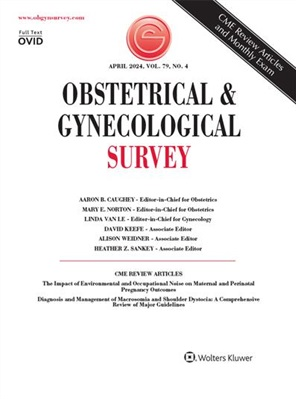无细胞 DNA 筛查的母体和胎儿异常发现。
IF 3.6
4区 医学
Q1 OBSTETRICS & GYNECOLOGY
引用次数: 0
摘要
重要性随着产前无细胞 DNA(cfDNA)技术的发展,cfDNA 所能提供的信息已超越了常见的胎儿非整倍体,如 21、18 和 13 三体。由于母体和胎儿/胎盘 DNA 的混合,产前 cfDNA 仍是一种筛查试验,有可能出现假阳性和假阴性结果。结果产前 cfDNA 可偶然发现一系列母体基因组异常,如恶性肿瘤、嵌合和拷贝数变异。当与胎儿诊断不一致时,这些病例需要进行额外的母体基因检测和随访评估。此类偶然的胎儿/胎盘异常可能包括罕见的常染色体三体、单亲裂殖和三倍体。对胎儿/胎盘畸形的进一步评估可结合超声检查和产前诊断,进行绒毛取样和/或羊膜穿刺。社会指南目前并不建议对罕见的常染色体三体、微缺失或拷贝数变异进行 cfDNA 筛查,一些专家建议应在咨询后选择性染色体筛查。相关性随着 cfDNA 技术的发展,其结果已包括全基因组的结果,因此临床医生、遗传咨询师和社会指南必须认识到,除了传统的非整倍体和性染色体非整倍体之外,还可能有其他各种结果。本文章由计算机程序翻译,如有差异,请以英文原文为准。
Unusual Maternal and Fetal Findings With Cell-Free DNA Screening.
Importance
With advances in prenatal cell-free DNA (cfDNA) technology, the information available with cfDNA continues to expand beyond the common fetal aneuploidies such as trisomies 21, 18, and 13. Due to the admixture of maternal and fetal/placental DNA, prenatal cfDNA remains a screening test with the possibility of false-positive and false-negative results.
Objective
This review aims to summarize unusual incidental maternal and fetal genomic abnormalities detectable by cfDNA and to provide anticipatory guidance regarding management.
Evidence Acquisition
Of 140 articles identified with keywords such as "incidental" and "discordant" cfDNA, 55 original research articles, review articles, case series, and societal guidelines were reviewed.
Results
Prenatal cfDNA may incidentally identify a spectrum of maternal genomic abnormalities such as malignancy, mosaicism, and copy number variants. When discordant with fetal diagnosis, these cases require additional investigation with maternal genetic testing and follow-up evaluation. Such incidental fetal/placental abnormalities may include rare autosomal trisomies, uniparental disomy, and triploidy. Further evaluation of fetal/placental abnormalities can be pursued with a combination of ultrasound and prenatal diagnosis with chorionic villous sampling and/or amniocentesis. Societal guidelines do not currently recommend cfDNA screening for rare autosomal trisomies, microdeletions, or copy number variants, and some experts suggest that sex chromosome screening should be opted in after counseling.
Conclusions
Knowledge about possible incidental findings with prenatal cfDNA is needed to inform pretest and posttest counseling with appropriate follow-up evaluation.
Relevance
As cfDNA technology has advanced to include genome-wide findings, it is important for clinicians, genetic counselors, and societal guidelines to acknowledge the spectrum of possible results outside of the traditional and sex chromosome aneuploidies.
求助全文
通过发布文献求助,成功后即可免费获取论文全文。
去求助
来源期刊
CiteScore
2.70
自引率
3.20%
发文量
245
审稿时长
>12 weeks
期刊介绍:
Each monthly issue of Obstetrical & Gynecological Survey presents summaries of the most timely and clinically relevant research being published worldwide. These concise, easy-to-read summaries provide expert insight into how to apply the latest research to patient care. The accompanying editorial commentary puts the studies into perspective and supplies authoritative guidance. The result is a valuable, time-saving resource for busy clinicians.

 求助内容:
求助内容: 应助结果提醒方式:
应助结果提醒方式:


